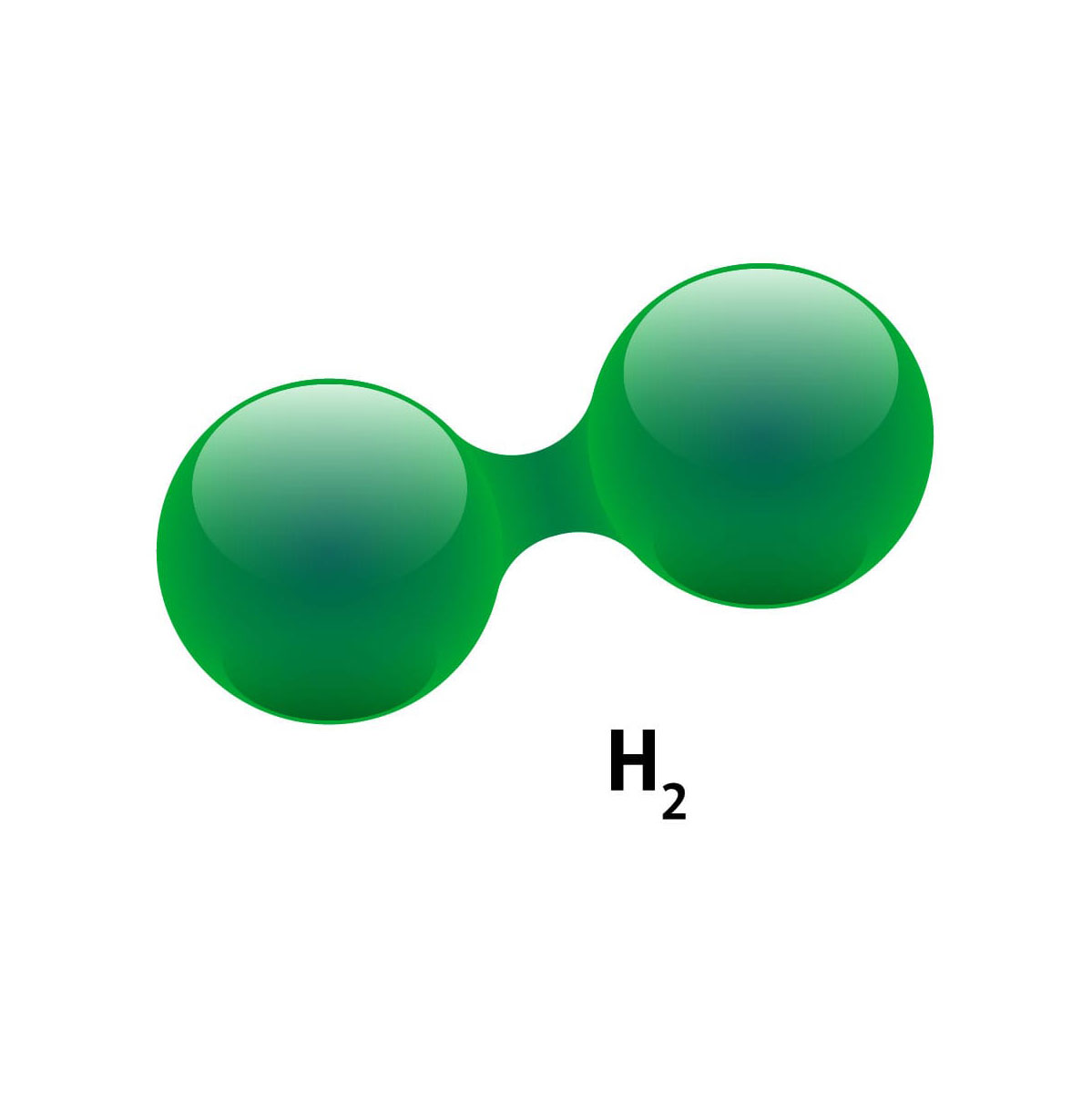WASSERSTOFF
2045 muss Deutschland klimaneutral werden
Für eine erfolgreiche Energiewende benötigen wir saubere Energieträger. Strom aus erneuerbaren Energien leistet schon heute einen wichtigen Beitrag zur Energiewende, jedoch wird für die Wärmeerzeugung bei Gebäuden oder in der Industrie deutlich mehr Energie benötigt – und die wird in erster Linie noch mit fossilen Brennstoffen erzeugt. Hier muss ein tiefgreifender Transformationsprozess in Gang kommen – und Wasserstoff als CO2-freie Alternative spielt dabei ein entscheidende Rolle. Das Land Niedersachsen setzt besonders auf „grünen“ Wasserstoff und hat schon frühzeitig eine Reihe von Initiativen und Veranstaltungen sowie Förderprogrammen auf den Weg gebracht. Als Energieland Nr. 1 soll Niedersachsen zu einem zentralen Standort der deutschen Wasserstoffwirtschaft werden.

Was ist Wasserstoff?
Wasserstoff ist das häufigste chemische Element im Universum, ein Energieträger, der vielseitig eingesetzt werden kann: Entweder durch Verbrennung als Wärmequelle und weiterverarbeitet als Biokraftstoff (e-Fuels), Methanol oder Ammoniak, oder direkt als Kraftstoff für Fahrzeuge mit einer Brennstoffzelle.
Gleichzeitig lässt sich Wasserstoff sehr gut speichern und kann zur erneuten Stromerzeugung genutzt werden, um so Versorgungssicherheit zu gewährleisten.
Wasserstoff – am besten grün
Wasserstoff ist das häufigste chemische Element im Universum. Für die industrielle Nutzung muss er jedoch durch Energiezugabe hergestellt werden. In der Regel mit Hilfe des Elektrolyseverfahrens, bei dem Wasser durch Strom in Sauerstoff und Wasserstoff gespalten wird. Je nachdem woher der Strom für diese Spaltung kommt, wird Wasserstoff farblich einsortiert, obwohl Wasserstoff an sich stets farblos ist.
Nur grüner Wasserstoff hilft uns bei der Energiewende, da der eingesetzte Strom aus erneuerbaren Energien wie der Windkraft stammt und somit CO2-frei ist. Deshalb konzentriert sich Niedersachsen bei der Produktion auf grünen Wasserstoff.
Grauer Wasserstoff wird in der Regel über Reformierung von Erdgas hergestellt. Bei der Herstellung einer Tonne H2 werden rund zehn Tonnen CO2 in die Atmosphäre emittiert.
Blauer Wasserstoff wird wie grauer Wasserstoff produziert – am Ende wird ein großer Teil des CO2 abgeschieden und im Untergrund gespeichert (Carbon capture und storage, CCS). CCS ist in Deutschland aufgrund unklarer geologischer Risiken und der begrenzten Speichermöglichkeiten umstritten. Darüber hinaus können sich Leckagen negativ auf die CO2-Bilanz auswirken.
Bei der Herstellung von türkisem Wasserstoff wird im Produktionsprozess kein CO2 freigesetzt, da der Kohlenstoff in fester Form gebunden und gespeichert wird. Allerdings muss für den Produktionsprozess Energie aufgewendet werden, die zu CO2-Emissionen führt, falls auf fossile Energieträger zurückgegriffen wird. Dieses Verfahren befindet sich noch in der Entwicklung und wird vor allem in Norwegen und den Niederlangen erforscht.
Es gibt weitere Farben, die sich am Markt jedoch noch nicht durchgesetzt haben, wie beispielsweise roten Wasserstoff aus Atomstrom.
Produktion von Wasserstoff
Elektrolyse
Wasserstoff kann auf mehrere Arten produziert werden. Die häufigste ist Elektrolyse. Hierbei wird in einem Elektrolyseur durch elektrischen Strom eine Redox-Reaktion hervorgerufen und durch die Aufspaltung von Wasser in seine Bestandteile Wasserstoff (H2) erzeugt. Hierfür gibt es mehrere Verfahren.
Alkali-Elektrolyse (AEL)
Die Alkali-Elektrolyse ist das älteste und verbreitetste Elektrolyse-Verfahren. Sie arbeitet mit günstig verfügbaren Materialien. Als Elektrolyt kommt eine Kalium-Hydroxid-Lösung (KOH) und als Elektroden beispielsweise nickelbasierte Elektroden zum Einsatz. Nachteilig ist der geringe Wirkungsgrad von ca. 68% und die mangelnde Fähigkeit auf schwankende Energiezufuhr zu reagieren (Dynamik).
PEM-Elektrolyse (PMEL)
Bei der PEM-Elektrolyse kommt statt eines flüssigen Elektrolyten ein Festpolymer-Elektrolyt als feste Membran (Proton Exchange Membran) zum Einsatz. Dadurch kann die Stromdichte erhöht und die Dynamik (Reaktionsfähigkeit des Elektrolyseurs bei fluktuierender Stromerzeugung) gesteigert werden. Außerdem ist der Wirkungsgrad der PEM-Elektrolyse geringfügig höher als beim AEL-Verfahren und erreicht bis zu 71%.
Hochtemperatur-Elektrolyse (HTE)
Die Hochtemperaturelektrolyse arbeitet bei Temperaturen von 100-900°C. Dadurch können Wirkungsgrade von bis zu 90% erzielt werden. Das wird dadurch erreicht, dass ein Teil der erforderlichen Reaktionsenergie thermisch in Form von Wasserdampf eingebracht wird. Daher bietet sich die HTE dort an, wo entsprechende Abwärme aus Produktionsprozessen genutzt werden kann (z.B. Stahlherstellung).
Die Hochtemperatur-Elektrolyse befindet sich noch in der Entwicklungsphase.
Pyrolyse und Plasmalyse
Methanpyrolyse und -plasmalyse sind neu erwogene Verfahren zur umweltfreundlichen Herstellung von Wasserstoff. Bei den Verfahren wird die notwendige Energie zur Aufspaltung des Methans in seine Bestandteile H2 und C in thermischer Form eingebracht. Die thermische Energie muss dabei aus regenerativen Quellen stammen.
Methan-Pyrolyse
Methanpyrolyse (oder auch Methancracken) ist eine endotherme Reaktion bei der durch Zufuhr thermischer Energie Methan (CH4) in seine Bestandteile C und 2 H2 zerlegt wird.
Für die Methanpyrolyse gibt es unterschiedliche Verfahren. Eine Möglichkeit zur Dekarbonisierung des Methans besteht in der Durchleitung des Methans durch ein elektrisch geschmolzenes Zinnbad, wobei der Wasserstoff nach oben entweicht und der Kohlenstoff als Schlacke auf dem Zinn abgelagert wird.
Plasmalyse
Eine Sonderform der Methanpyrolyse ist die Plasmalyse, z.B das Kvaerner-Verfahren. Hierbei wird Methan in einem elektrisch erzeugten hochfrequenten Plasma in seine Bestandteile zerlegt. Die freiwerdenden Wasserstoffmoleküle werden aufgefangen, der Kohlenstoff fällt auch hier in fester Form an. Im Vergleich zur Elektrolyse soll der Strombedarf um bis zu 75% geringer sein.
Mittels Plasmalyse kann auch Schmutzwasser in seine Bestandteile zerlegt und dadurch gleichzeitig das Wasser gereinigt und Wasserstoff gewonnen werden.
Einsatzmöglichkeiten von Wasserstoff
Wasserstoff ist als Energieträger sehr wandelbar und damit vielseitig einsetzbar. Dadurch bietet er Dekarbonisierungspotential für viele Anwendungsgebiete. Da sauberer Wasserstoff derzeit aber knapp und kostbar ist, diskutieren Politik, Wirtschaft und Wissenschaft derzeit, wo er am sinnvollsten eingesetzt werden kann. Prinzipiell ist der Einsatz in vielen Industriezweigen möglich, wie beispielsweise der Stahlproduktion, der Grundstoff- und Chemieindustrie, sowie im Verkehrrsektor, im Schienen- und Flugverkehr.
Letztlich ist der Einsatz vor allem dort nötig, wo die größte Emissionsreduktion erreicht werden kann und keine Alternative zur Dekarbonisierung unserer Wirtschaft besteht. Deshalb sollte der grüne Wasserstoff eingesetzt werden, um die Grundstoff- und Chemieindustrie zu dekarbonisieren, sowie in Wasserstoffkraftwerken. Für den Gebäudesektor und Individualmobilität sollte Wasserstoff dagegen eine untergeordnete Rolle spielen, da durch den Einsatz von Wärmepumpen und batterieelektrischen PKW bereits deutlich energieeffizientere Technologien zur Verfügung stehen, die eine schnellere und kostengünstigere Treibhausgasemissionsreduktion ermöglichen.
Zukunftsweisende Projekte zur Erzeugung von Wasserstoff, der Speicherung sowie Transport und Anwendungen in Industrie und Mobilität finden Sie hier.
